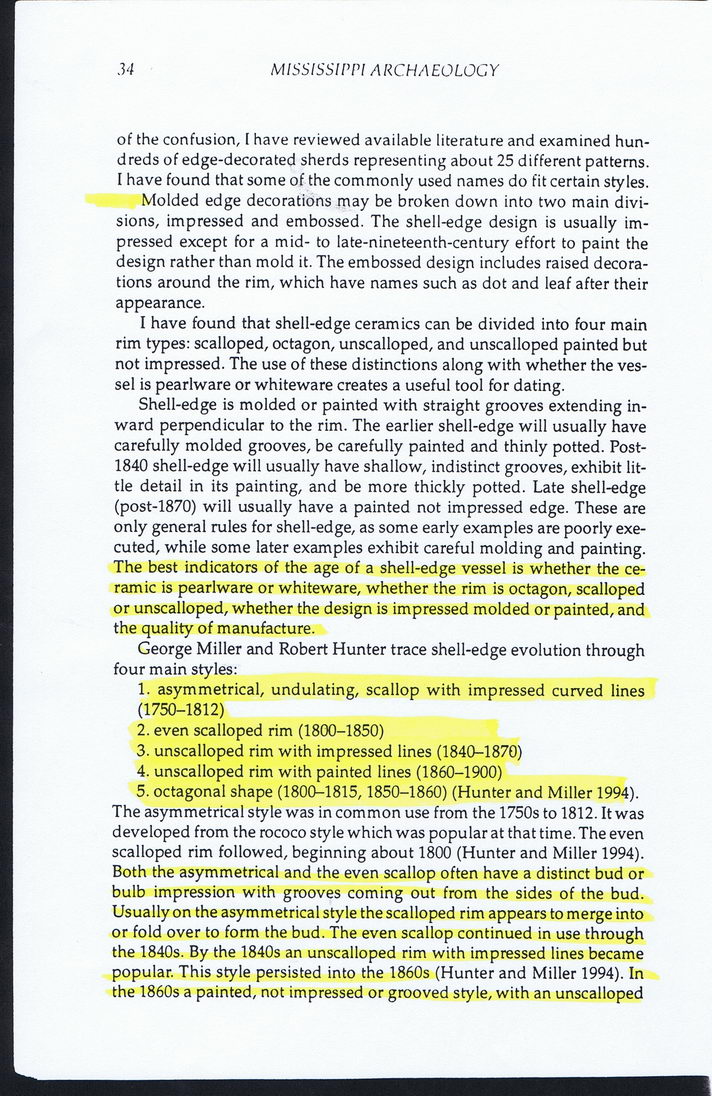This text was obtained via automated optical character recognition.
It has not been edited and may therefore contain several errors.
34 MISSISSIPPI ARCHAEOLOGY of the confusion, [ have reviewed available literature and examined hundreds of edge-decorated sherds representing about 25 different patterns. I have found that some of the commonly used names do fit certain styles. Molded edge decorations may be broken down into two main divisions, impressed and embossed. The shell-edge design is usually impressed except for a mid- to late-nineteenth-century effort to paint the design rather than mold it. The embossed design includes raised decorations around the rim, which have names such as dot and leaf after their appearance. I have found that shell-edge ceramics can be divided into four main rim types: scalloped, octagon, unscalloped, and unscalloped painted but not impressed. The use of these distinctions along with whether the vessel is pearlware or whiteware creates a useful tool for dating. Shell-edge is molded or painted with straight grooves extending inward perpendicular to the rim. The earlier shell-edge will usually have carefully molded grooves, be carefully painted and thinly potted. Post-1840 shell-edge will usually have shallow, indistinct grooves, exhibit little detail in its painting, and be more thickly potted. Late shell-edge (post-1870) will usually have a painted not impressed edge. These are only general rules for shell-edge, as some early examples are poorly executed, while some later examples exhibit careful molding and painting. The best indicators of the age of a shell-edge vessel is whether the ceramic is pearlware or whiteware, whether the rim is octagon, scalloped or unscalloped, whether the design is impressed molded or painted, and the quality of manufacture. George Miller and Robert Hunter trace shell-edge evolution through four main styles: 1. asymmetrical, undulating, scallop with impressed curved lines (1750-1812) 2. even scalloped rim (1800-1850) 3. unscalloped rim with impressed lines (1840-1870) 4. unscalloped rim with painted lines (1860-1900) 5. octagonal shape (1800-1815,1850-1860) (Hunter and Miller 1994). The asymmetrical style was in common use from the 1750s to 1812. It was developed from the rococo style which was popular at that time. The even scalloped rim followed, beginning about 1800 (Hunter and Miller 1994). Both the asymmetrical and the even scallop often have a distinct bud or bulb impression with grooves coming out from the sides of the bud. Usually on the asymmetrical style the scalloped rim appears to merge into or fold over to form the bud. The even scallop continued in use through the 1840s. By the 1840s an unscalloped rim with impressed lines became popular. This style persisted into the 1860s (Hunter and Miller 1994). In the 1860s a painted, not impressed or grooved style, with an unscalloped

Poverty Point (Indian Culture) Shell-edge Decorated Ceramics - Rufus Ward (08)